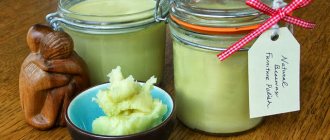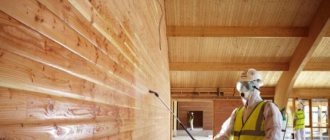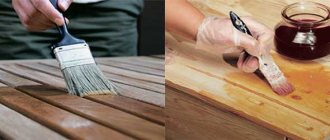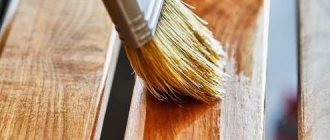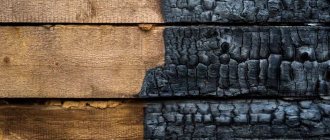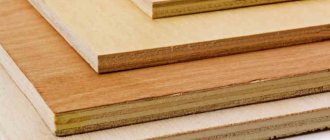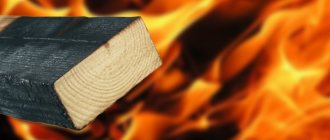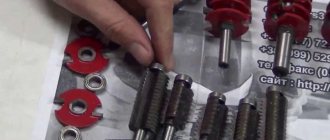Wood is soft but durable, a favorite material for many to build houses on summer cottages. Even if the building is built of brick or foam blocks, logs, beams or boards are used to build a bathhouse, garage, gazebo, veranda. You can’t do without wooden decor - a well, benches, swings, bridges. Fences and fences are also made of wood. To avoid rapid destruction of the material, effective protection of wood from external factors is necessary: excessive moisture, fire, insect pests.
- 2 Methods of protection against rotting
- 3 Fire retardants - reliable fire protection
- 4 Insects - no chance!
- 5 Comprehensive protection of residential buildings
How to protect wood from moisture?
If the moisture content of the material exceeds 15%, the structure of the wood begins to collapse: swell, delaminate, and then shrink. As a result, the products change their shape, cracks and gaps appear. Almost all wooden elements are susceptible to high humidity, with the exception, perhaps, of sisal and rattan, since they come from the tropics.
The experiment showed that water does not penetrate the pores of a block treated with a water-repellent composition, while it is quickly absorbed into unprotected wood
There are special solutions that protect wood from moisture. They are divided into two groups:
- penetrating;
- film-forming.
The first group provides a more reliable barrier against the penetration of liquid into the wood structure. The process of treatment with compounds of the second group must be repeated over time. Let's look at two products that resist high humidity.
Aidol Langzeit-Lasur is a medium-viscosity impregnating composition, excellent for covering house walls, country furniture, balcony and terrace railings, and fences. The azure is so safe that it can be used to cover children's toys and buildings. It has many decorative shades: silver-gray, teak, ebony, dark oak.
If coniferous wood is treated with Aidol Langzeit-Lasur, it must first be primed. This rule also applies to products damaged by fungus or mold.
Belinka Interier Sauna contains acrylic resins, water and additives. This is a colorless glaze, ideal for processing wood in baths or saunas. Two layers of the solution are applied with a roller, brush or spray.
Belinka Interier Sauna does not mask the natural texture of wood, but only makes it more silky and shiny. A 2.5 liter jar of azure costs 950-1000 rubles
Four stages of wood destruction
Elementary. The fungal mycelium progresses only on the outer shell of the tree; the internal structure retains its integrity. The color of the wood becomes grayish-gray.
Development. Uneven pits appear on the wooden part. On the cut, you can find white layers of mycelium among the tree rings.
The final stage. The wood has lost its strength. It either crumbles or splits into small chips.
Mechanical destruction of the wood structure in a separate area. Hollow formation.
DIY tool box according to drawings: instructions with step-by-step guide- Form for paths - a large selection of forms and a simple method for creating a beautiful and comfortable garden (photo + video)
Do-it-yourself snow blower - we remove snow easily, an overview of designs and types for a suburban area
Methods of protection against rotting
Temperature changes, precipitation, and solar radiation lead to untimely rotting of wood. The first signs of decay are the appearance of mold and mildew. Large areas indicate that the material can no longer be saved. If wooden products or buildings experience atmospheric disturbances, high humidity from precipitation and condensation, it would not be a bad idea to carry out preventive work that will protect the wood from rotting.
The best helpers in this matter are antiseptics, which are pastes or liquid solutions. Some of them are universal, that is, they protect the material not only from moldy fungi, but also from beetles. Examples of such compositions are two popular products.
PINOTEX IMPRA is used for treating wooden surfaces that are not subject to further decoration. Usually these are beams, roofing straps, sheathing parts, that is, hidden parts of buildings. The impregnation is green. The appearance of mold, blue stains, fungus and rot is excluded on wood coated with it.
Recent Entries
Lilac perennials that are beautiful, compact and do not crowd out other plants Why when buying seedlings you should not take the sellers’ word for it and how to determine the age of the plant using 3 signs Tomato seedlings have turned purple or whitish: why the color has changed and how to save the plants
Antiseptic Pinotex Impra goes on sale in large-volume containers. Product price: 3 l – 1100 rubles, 10 l – 3350 rubles
Senezh Ecobio is used both as an independent coating and as a primer for varnish or paint. 2-3 layers of the product protect wood from rotting for 30 years.
If the wooden surface was originally treated with varnish, paint, drying oil or other water-repellent agents, SENEZH ECOBIO is useless
how much are ebony sex doll?
For all its advantages, untreated wood is not a durable building material. In order for a house, fence, gazebo, garden furniture and other elements of both the building itself and the suburban area to last a long time, wood requires reliable protection.
Ways to protect wood
Wood structures and parts have long been in demand in construction due to their environmental friendliness, manufacturability and mechanical strength. Today almost no house can do without wooden elements: rafter systems, floor beams, internal partitions, stairs and balustrades - all this is most often made of wood. But this material has enemies - fire, mold, fungi, insects and ultraviolet radiation. To protect wood from such negative factors, both constructive methods (correct placement, layout and operation of products and buildings) and special chemicals are used - therapeutic and prophylactic (antiseptics), protective and decorative (impregnations, glazes, varnishes) and fire-fighting (fire retardants) ). The best option is a combination of several methods of protecting wood for one structure, plus regular monitoring of its condition and periodic renewal of the outer covering (on average, such procedures are carried out every 4-5 years). In any case, prevention will be much cheaper than restoring an already damaged element.
Related video:
How to choose fire protection or bioprotection for wood?
When choosing fire and bioprotective agents for wood, you should follow special recommendations and carefully study the information on the product packaging.
- Manufacturer . Wood preservative is a rather complex product, and only a well-equipped enterprise with a long production history can produce it with high quality. Therefore, products of dubious and little-known origin should not be trusted.
- Coating service life . If a manufacturer claims that their product provides a protective layer that will last 2.3 years or 5 years, then this is most likely true. But when it comes to 20-40 years, it is better to refrain from buying. Only the most attentive buyers will pay attention to the fact that under this phrase, as a rule, there is a footnote where it can be written, for example, that such a period of protection is possible provided that the solution is applied by deep impregnation or soaking. Both of them are industrial methods, unattainable in everyday conditions. Another version of the so-called marketing ploy is that the manufacturer, under the promised long life in small print, writes that such durability is achieved provided that the composition does not wash out of the wood, which is impossible in principle.
- Composition consumption . As a rule, the cheaper the impregnation, the higher the consumption declared by the manufacturer. Therefore, when you see a seemingly inexpensive product on a store shelf, you should not rush to buy it. To begin with, it is better to calculate how much impregnation will be required to solve a specific problem, subject to the manufacturer’s recommendations for consumption. The average consumption rate should not exceed 200-250 g/m2. And on some products you can find figures of 500-600 g/m2, which is quite typical for fire-retardant materials, but cannot in any way be the norm for bioprotective compounds.
- Versatility . When choosing a complex bio-/fire retardant agent, you need to take into account that some manufacturers deliberately combine the functions of antiseptic and fire retardant actions, speaking of their mutual reinforcement. But experts say that even seemingly compatible compounds in a solution may not only fail to provide a positive effect of enhancing each other, but also reduce the bio-/fire-retardant properties. It is better to purchase specialized tools for solving different problems separately.
- Availability of a certificate . All fire retardant compounds and materials must have a certificate of conformity and a conclusion from the sanitary-epidemiological station. Without these documents, the sale of fire retardant products on the territory of Ukraine is prohibited. Require the presentation of appropriate confirmation at points of sale!
Bioprotection - protection of wood from rotting and insects
Constant wetting of the surface and the accumulation of condensation on it lead to the formation of fungi and mold, and the appearance of rot. And wood is much more difficult to withstand the effects of dampness than all other building materials. Moisture can destroy wood cells, cause decomposition and splitting of structures. If the process is not prevented or stopped in a timely manner, then in a few months the rot will “eat through” the tree. As a result, the beam or truss structure will collapse, pulling other building and finishing materials with it. Their bioprotective treatment will help to avoid such consequences.
Raw material selection
You need to take care of protecting wood from rotting even at the stage of purchasing and storing timber and lumber. In production conditions, wood harvesting goes through several stages: cutting, treatment with a preservative composition, drying for a year, sawing. Technological violations at least at one of the stages lead to the appearance of harmful bacteria and insect larvae in the material.
In any case, when choosing wood, it is useful to know that different species have different resistance to rot. Hardy trees include pine, ash, cedar, larch and oak, medium hardy trees include spruce, fir and beech, and low hardy trees include birch, elm, hornbeam and maple. If defects were discovered after the purchase of the material, it must be treated with an antiseptic before storage, including “healthy” products for prevention.
It is difficult to determine the condition of a tree by eye. Of course, it is necessary to screen out wood with obvious signs of waterlogging: for example, if the board has a helical shape (distortion of the cross section), there is blue discoloration or small pockets of mold. But only a person with extensive experience in the specialized field (for example, a carpenter) will be able to indicate a moistened product - by the presence of cracks in the end, barely noticeable warping of the material, and the approximate weight of workpieces of common types. An inexperienced person will determine this only during processing. Signs of very wet wood - the shavings removed with a plane are easily crushed, and the shavings from the cross use of the chisel crumble.
The standards contain more precise requirements for the moisture content of wood materials used for certain needs:
- construction of walls and fences - 6-20%;
- installation of rafter structures and laying of beams - 9-15%;
- installation of window and internal door units - 6-12%;
- installation of external door frames - 9-15%;
- creation of interior finishing parts - 9-15%',
- manufacturing of platbands and external cladding - 12-18%.
It is important to take into account that the humidity of small parts and connecting elements should be 2-3% lower than that of the main product in which they are used.
Assortment classification
Impregnations, disinfectant and antifungal solutions, etc. are used as special antiseptic agents. The choice of composition is determined by the designated task and the property of the necessary protection. It should be taken into account that different types of wood absorb drugs differently, and the consumption of the product depends on this. Thus, pine, birch and beech wood have good absorption; cedar, larch, hornbeam, oak, maple, linden, alder and aspen have moderate absorption; spruce and fir have low absorption.
Insecticidal impregnations that destroy insect larvae and prevent their appearance have an “ambulance” effect. Such preparations are made on a water or alkyd basis. The former serve mainly for temporary (annual) conservation of wood for the period of harvesting, transportation and storage. Alkyd-based antiseptics work much longer. They create coatings that are resistant to fading in the sun and do not absorb water, and are also suitable not only for medicinal purposes, but also for preventive treatment.
Preparations intended to combat fungal diseases of wood (mold, blue, brown and brown rot) contain special substances in their formulation - fungicides. Fungicidal solutions are made based on water or white spirit. Solutions of the first group are environmentally friendly, inexpensive, but are washed out with water over time, so it is better not to use them for treating elements that are in direct contact with the soil and moisture. Preparations based on white spirit penetrate deeper into the wood, are not washed out with water, but are less environmentally friendly (they have a strong, specific odor that complicates the processing process).
Well, if the wood has been subjected to fungal infection, the entire surface is thoroughly cleaned and special disinfectants with a high content of active substances are used, including those that can bleach wood that has changed its color.
Transparent "cosmetics"
Lazuries and varnishes not only protect wood from ultraviolet rays and precipitation, but also give it an attractive decorative effect.
Varnishes intended for interior use are environmentally friendly and are characterized by increased resistance of the finished coating to abrasion and moisture. Varnishes for external use, made on an organic basis, create an elastic coating of increased strength that protects wood from temperature and humidity atmospheric fluctuations and exposure to ultraviolet radiation.
Lazuries (glazing compounds), being transparent, leave the wood texture visible. They serve to protect and decorate new, previously unpainted surfaces. Compared to paints, the protective effect of glazes is much higher. Firstly, the content of coloring pigments in them is minimal, which ensures good absorption into wood, and secondly, they contain many more special additives that prevent rotting of the material. For long-term use in atmospheric conditions, dark-colored glazes are more suitable: they better mask the graying of wood, and their service life is on average 3-4 years (for light glazes - 2-3 years).
Fire protection - protecting wood from fire
In a dry state, wood ignites and spreads fire, at a temperature of 200-250 ° C it chars, and at 300 ° C it begins to collapse. We should also not forget that construction products and materials can release toxic products during combustion that are hazardous to human health. Therefore, it is very important to limit the time of exposure to fire on the structural elements of the building. To combat the low fire resistance of wood, special fire retardant compounds are used - fire retardants, which reduce the flammability of the material and protect its surface from the spread of flame.
Theory and practice
Wood has an interesting quality: the larger the cross-section of a wooden structure, the more difficult it is to ignite, and when burning, coal is formed on the surface, smoldering more slowly. Therefore, massive bars and logs retain their load-bearing capacity during a fire for quite a long time.
It is also worth noting that the heat reflectivity is higher for a wooden structure with a smooth surface, that is, it is more difficult to ignite. Any chips, protrusions and cracks increase the likelihood of fire.
If you are building a completely wooden house, fire retardant treatment will be required for all structures, including external walls.
In a house made of other materials, wood, which is used in the attic floor and roof structure, requires priority attention, since their collapse is dangerous to human life and can lead to an increase in the area and intensity of the fire. Fire-retardant treatment of wooden surfaces in places of normal and emergency evacuation is also necessary - entrance areas, terraces, first floor balconies, stairs, etc. In addition, attention should be paid to places where there is an increased risk of fire - around sockets, near the fireplace, etc. d.
To protect wood from fire, constructive measures are also used, such as increasing the cross-sections of the most loaded wooden elements, removing wooden structures from fire sources or creating fireproof cladding, etc.
Assortment classification
For wood processing, two groups of fire-retardant materials are used, which are divided depending on the methods of their application - impregnation and coating.
- Fire retardant impregnations are solutions of phosphoric or boric acid salts, most often water-soluble. Under their protection, wood chars at the point of contact with fire, and the structure as a whole resists fire for a long period and prevents the spread of flame.
- Fire retardant coatings are paints and varnishes that create a thin heat-reflecting layer on the surface of wood. When exposed to high temperatures, it swells, forming a heat shield of solid non-flammable foam (similar to the action of a fire extinguisher), which prevents ignition and the spread of flame over the surface and slows down charring.
It is better when wood is treated with fire retardants in an industrial environment. In this case, the drug under pressure penetrates as deeply as possible into the wood, so this fire protection is more durable. When purchasing untreated material or when the initial treatment has expired, you will have to solve the problem yourself. Apply the protective agent using a brush or spray gun only to a clean, dry surface.
Compliance principles
When independently choosing a fire retardant for wooden structures at home, you should take into account its effectiveness indicators. So, all funds are divided into three groups. The compositions of the first group, according to test results after two minutes of exposure to a gas burner flame, allow a mass loss of a wood sample of no more than 9% and ensure the production of a wooden structure with flammability class G1, the second - a mass loss of 9-25% and flammability class G2. Products of the third group do not provide adequate fire protection for wood, so they are not worth buying. It is also better not to buy compounds whose effectiveness has not been indicated by the manufacturer.
For processing wooden rafters and finishing stairs, materials with flammability class G1 are used; for all other cases, products of class G2 are sufficient. Information about the level of fire retardant effectiveness must be indicated on the packaging.
Fire retardants - reliable fire protection
To protect wood from fire, there are fire-resistant solutions - fire retardants. For residential buildings they are mandatory. Under the influence of a flame, the substance with which the wood is impregnated turns into a thin film that can prevent the flame for some time. Coatings come in different forms:
- solutions;
- plasters;
- paints;
- coatings.
Sample of fire retardant – NEOMID 530, impregnation for external and internal use. Guaranteed service life – 7 years. Reliably protects wooden walls, ceilings, door and window blocks, and partitions from fire. The composition of the fire retardant does not change the structure of the wood. Varnishes, paints, and primers can be applied over the fire retardant solution.
It should be borne in mind that when applying fire retardant NEOMID 530, slight tinting of the material occurs, depending on the type of wood, so it is recommended to carry out testing before starting work
Pirilax is a biopyrene that protects wood from fire and localizes fires. The prefix bio- means that the product is also a barrier to mold and insects. The solution provides effective protection inside and outside the building, and is safe for use on buildings for poultry and livestock.
Pirilax for external use is not washed out by precipitation for 13-15 years. Indoors it provides protection for 25 years
Expert Recommendation
If you are building a wooden house or bathhouse, then without any doubt it is necessary to treat the entire surface of the wooden structures, inter-crown insulation made of jute and preferably additional insulation under the roof, in order to prevent rotting and accidental fire of the wood. In addition, it is very good if you additionally process all the dowels that will fasten your log or beam walls of a wooden house or bathhouse.
Photo: treatment of lumber with agents against wood decay (mold and rot) must be carried out at any construction site. It is especially important to treat lumber with antiseptics during the construction of wooden houses. If you are building a house from timber or a house from rounded logs, then it is best to choose for antiseptic treatment the compositions Neomid 440 for external treatment of logs (timber) and Neomid 400 for internal treatment (impregnation) of timber and logs. If holes are found in the structure of logs and beams due to the work of pest beetles, it is best to additionally impregnate all wooden structures with Neomid 100 “Anti-Bug” impregnation.
Insects - no chance!
Tiny beetles can turn wooden furniture, walls and floors of your home into dust. Borer beetles, longhorned beetles and weevils, together with their larvae, slowly but surely destroy untreated building material. Only protecting wood from harmful insects will save the situation.
It is much easier and cheaper to take preventive measures than to replace damaged logs and beams. Insecticidal solutions will drive established pests out of their shelters and block the way for newcomers. You can use folk remedies - a solution of tar in turpentine, chlorophos, paraffin or a mixture of kerosene and carbolic acid. But formulations for professional processing are more effective.
Aqua-varnish Bor saturates the surface of the wood, protecting it from any negative manifestations from the outside, including beetles. It is used to cover window and door blocks, baseboards, stairs, railings, fences, and wooden walls of houses. Transparent impregnation does not distort the texture of the wood, it only changes its color to the desired one. The varnish can be diluted with water, but its percentage should not exceed 10%.
The number of layers of Aqua Varnish applied depends on the location of the wooden elements: two are enough indoors, at least three outside.
Antiseptic Tonotex serves both to protect wooden surfaces and for decoration. Its composition emphasizes the texture of wood without changing its properties. A range of different shades allows you to give ordinary wood the color of one of the valuable types of wood.
Tonotex is one of the universal compounds that are used for processing wood on the territory of a summer cottage: it will protect both from atmospheric hazards and from biological threats
How to destroy house fungus? What's better?
In a poorly ventilated and humid house, you can notice the appearance of the most dangerous porcini mushroom. Moreover, it is harmful not only to wooden structures, but also to human health. Therefore, when it is detected, you need to immediately begin to fight it, and it is much easier to get rid of it in the initial stages of its development. How to choose an antiseptic for a log house? This is not a very difficult question. There is a huge amount of recommended literature on the Internet that is worth reading before making your choice. According to our estimates and the opinion of numerous builders of wooden houses, the best impregnations in the fight against rotting and fire include compositions of the Neomid brand. These are very good and effective means of protecting wooden structures from mold, rot and rot. Neomid 450-1 is considered the best drug for fighting fire and ignition of wood products.
Climatic factors
Wood is able to absorb and release moisture, adapting to environmental conditions. Repeated cycles of drying and swelling lead to the formation of cracks, which provide access to insects and microorganisms.
“Aggravating” circumstances include:
- Seasonal temperature fluctuations. The higher the moisture content of the material, the more serious the changes will be.
- Precipitation . Direct (rain, snow) and indirect (fog, evaporation) contact with water leads to the accumulation of moisture in wooden structures and their subsequent deformation.
- Solar radiation . UV radiation with a wavelength of less than 380 nm causes changes at the molecular level, causing the wood to take on a grayish tint and delaminate. Rays with a wavelength of more than 720 nm heat the upper layers, and the temperature of the inner part remains stable due to the insulating properties of the material. Due to uneven shrinkage, cracks appear on the surface.
- Oxidation . Under the influence of oxygen, physical and biochemical reactions occur in wood: tannins are absorbed into the cell walls, resins thicken, and water-soluble elements crystallize. When wood oxidizes, it darkens.
The most significant damage is caused by constant changes in humidity combined with solar radiation. When the moisture content is more than 20%, the risk of fungal damage increases. The longer high humidity levels persist, the greater the danger.
Summary
The protective agent must penetrate deep into the wood and protect the inner layers from biological influence. At the same time, a barrier must remain on the surface that resists ultraviolet radiation, moisture, temperature fluctuations and physical impact. For most buyers, it is important that the antiseptic has tinting and decorative properties, but does not spoil the appearance of the wood.
One product is not able to protect the material from all destructive factors, which is why we offer ready-made complexes consisting of two products. They complement each other and increase the intervals between planned treatments of wooden buildings.
Comprehensive protection
The destruction of wooden buildings follows approximately the same scenario. First, the surface is exposed to precipitation and solar radiation - the fibers soften and peel off. As a result of seasonal temperature changes, the bonds between the fibers are broken, but cracks appear on the surface. Damaged and loose material accumulates excess moisture and dust, which creates excellent conditions for the proliferation of fungi. If mechanical stress is added to this process, the destruction occurs at an accelerated rate.
Most often, wood is exposed to a number of atmospheric, technogenic and biological factors, which require comprehensive protection. In a professional environment, the concept of “protection class (use) of a wooden element” is used, described in the DIN 68800-3 standard. The standard identifies several types of arrangement of wooden structures and determines the required type of material processing.
| Class | Where is the wood located? | Protection |
| 0 | Premises with a standard residential microclimate. Contact with insects is excluded. The wood is veneered or can be inspected at any time. | No decorative required. |
| 1 | Dry and heated environment (air humidity less than 70%). Internal parts of walls, roofs, interfloor ceilings. | Preventive treatment against wood-destroying insects. |
| 2 | Rooms with high humidity (more than 70%). External structures that are not in contact with the soil and are not exposed to atmospheric influences. | The treatment is water-repellent, against insects and fungi. |
| 3.1 | Elements subject to precipitation, but not constantly in contact with soil or water. Accumulation of water in the material is excluded. | Waterproof against fungi and insects, resistant to thaw/freeze cycles. |
| 3.2 | Similar to point 3.1, but there is the possibility of water accumulation. | Permanent antifungal and insect repellent, resistant to thaw/freeze cycles. |
| 4 | Constant contact with water or soil. Extreme weather conditions. | Enhanced protection against fungi (rot), insects, resistant to thawing/freezing cycles. A product that is fixed in the wood is needed. |
Causes of destruction of wooden structures
Natural, technogenic and anthropogenic factors that can affect the integrity and health of the log walls:
- Ultraviolet radiation destroys lignin, which is the reinforcing framework of wood. When exposed to direct sunlight, outside surfaces darken, become porous, easily absorb moisture and quickly release it. As a result, the logs age prematurely and crack.
- Precipitation and high air humidity lead to swelling and then shrinkage of wooden structures. Damp wood is a favorable environment for the proliferation of fungal microorganisms and mold outbreaks. A rotting corner of a log house can cause the destruction of a house.
- Insect pests and rodents that can settle in the walls of a log house damage the integrity of the tree.
- Exposure to concentrated acid-base solutions affects the chemical composition of the tree and changes its physical properties.
- Fire is one of the most destructive factors that can destroy a wooden frame in a very short period of time.
- Uneven heating of the walls of the house, the formation of condensation on their surface, dry indoor air in winter - all these are the results of human activity, which also adversely affect the condition of wooden structures.
The inevitability of the influence of one or more factors convinces of the need to treat the internal and external surfaces of a wooden structure.
Drying wood.
Natural drying is carried out in the open air, under canopies (for protection from rain and sunlight) or indoors so that the material takes on an air-dry state (15-20% humidity).
Such drying lasts weeks and even months; it does not exclude the possibility of wood being damaged by fungi. Its advantage is the absence of thermal energy (fuel) consumption.
Artificial drying is carried out in a short time, for example, within a few days or hours. It completely eliminates the possibility of infection by fungi and ensures high quality wood. There are several types of artificial drying, carried out at almost any time of the year.
Chamber drying is carried out in batch and continuous dryers for several days. The coolant is heated air, steam or flue gases at a temperature of 70-80°C. Wood is also dried in a high frequency electric field. The wood is quickly and evenly heated between the electrodes and dried 10-20 times faster than with chamber drying. Heating in high-frequency (HF) and ultra-high-frequency (microwave) electromagnetic fields is one of the most advanced methods of drying wood and wood-based materials. The main advantage of using microwave heating is the automatic equalization of humidity, since places with higher humidity generate more heat than places with less. In the production of particle boards and fiberboards, leveling the moisture content of chips or wood wool allows reducing processing time and loss of raw materials; reduce binder consumption and improve the quality of slabs.
A cheaper method is drying in liquid media, in particular in baths with petrolatum (a waste product from the dewaxing of petroleum oils) at a temperature of 130-140°C. Within a few hours, the moisture in the wood boils, turns into steam with a pressure higher than atmospheric and is removed; At the same time, the material does not crack or warp. Drying in petrolatum is no more expensive than chamber drying, its duration is 8-12 hours.
16 pp., 7970 words
Technological process for the production of particle boards
... technological operation where W is the moisture content of the material at a given technological operation on a given flow. The calculation results are shown in Table 1. For the production of slabs, raw materials of mixed species are used. We determine the weighted average density of wood...
